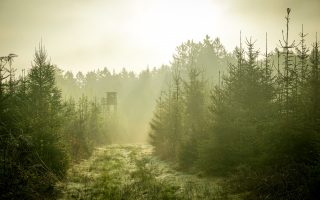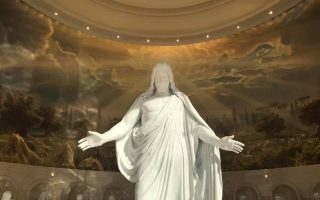This post was written by Sophie Hirtle, a Humanities Center student fellow.
My great-grandmother Mary Abbott Self loved to write. While she kept most of her works to herself, she was especially proud of an article she published in 1951 in the Independent Press-Telegram in Long Beach, California. In her article, she describes the beauty of the wildflowers throughout Southern California as the state transitioned from a sleepy winter to a vibrant spring. The article itself is mainly informative, providing the reader with an overview of the best areas to view these elegant blooms. But Mary decided to end her article on a more pensive note: “There seems to be something symbolic about the wildflowers. Here on the rugged mountainsides they grow untended, almost unprotected, yet like tiny flags waving gallantly in triumph over all adversity, a tribute to God and man.”
As more of these blooms begin to pop up across campus, I find myself reflecting more on Mary’s beautiful tribute to wildflowers as symbols of our shared tenacity. Wildflowers are identified based on their ability to grow naturally without human intervention. It is believed that wildflowers have existed for millions of years, proving their adaptability and fortitude. Yet we often brush them aside as fragile creations or, even worse, weeds.
In fact, one of the most common wildflowers is often referred to as a troublesome and invasive weed. The dandelion, whose bright yellow head dots many a lawn, was once praised for its beauty and medicinal purposes. Their ability to survive and propagate with a single gust of wind made them ubiquitous, serving as small reminders of beauty.
And yet, most people do not think about divine tenacity when observing the dandelion. It is a detractor from the cultivated perfection of the impossibly green lawn. While it would be incredibly cliche to use the metaphor of the dandelion to summarize humanity’s problems, these small flowers do serve as examples of how we can bring divinity back into daily existence, especially in the realm of the humanities.
In Romanticism, the natural world served as inspiration for many of the most iconic works of literature and art as the individual within the realm of the natural world became a key figure in the movement. These writers did not just consider the beauty and divinity of wildflowers, but also of the heavens, trees, and lakes. In Anne Brontë’s The Tenant of Wildfell Hall, for example, the protagonist, Helen, spends much of her time out in nature as she works on her paintings and seeks an escape from her tumultuous past. At one point in the novel, the narrator describes her artistic approach in greater detail: “Mrs. Graham was studying the distinctive characters of the different varieties of trees in their winter nakedness, and copying, with a spirited, though delicate touch, their various ramifications” (50). Her inspiration came from taking the time to wander through nature and wonder about the existence of the trees around her. Later in the novel, Helen discusses her own personal feelings during these moments of reflection: “I saw distinctly the pure moon shining on, and the light clouds skimming the clear, dark sky; and then, I saw the eternal stars twinkling down upon me; I knew their God was mine, and He was strong to save and swift to hear” (305).
Helen’s most profound artistic endeavors stemmed from these moments she spent wandering around in nature and wondering at the world around her. Yes, she dedicated much of her time to practicing her painting within her home, and she spent hours trying to perfect her technique, but she also acknowledged that the depth in her art stemmed from this divinity she found in the ubiquity of nature. While Helen does not specifically mention wildflowers, her musings on wandering in nature reflect those of my great-grandmother as both turned to commonplace images in nature in order to find inspiration for their creative productions.
Thus, in the humanities, it is necessary to consider these small, seemingly insignificant forces of beauty in our own creative productions, taking time to step away from the mountains of articles in order to remind ourselves that the pursuit of knowledge within the humanities should always be centered on this element of wonder regarding the world around us.
I do concede that in 2025, it is becoming increasingly difficult to step away from the concrete plans of day to day living and most of us do not have time to go live in the woods like the Romantics from the past. I know that I have felt this hesitation to stop my current trajectory and “wander among the dandelions” as I have considered my future plans for graduate school during a time of budget cuts and growing uncertainty in the academic realm. My green lawn of graduate school, academic research, and teaching appointments that I have spent years cultivating has now been interrupted with these dandelions, or detractors from my original plans. I will wholeheartedly admit that I felt incredibly frustrated when these perceived distractions popped up—I still do. But these small diversions have provided me with opportunities to contemplate my goals and think more profoundly about why I have made them, rather than continue my studies at a breakneck pace without considering my deeper motivations.
In this time of uncertainty in the humanities, diversions in the path (or dandelions in the lawn) provide opportunities to contemplate the deeper reasoning behind academic endeavors. Thus, in taking time to consider the tenacity of those small springtime blooms, we can also remind ourselves that in order for the humanities to continue, one must allow the mind and body to wander in order to help others become aware of those small pockets of divinity. After all, if those Romantic novelists and artists did not take time to wander and wonder, would we see the natural world as we see it today? Would we possess this same drive towards divinity while observing the stars and flowers? In the humanities, we must then act as the wandering wonderer, never letting ourselves forego the dandelion in order to achieve the perfect lawn.






